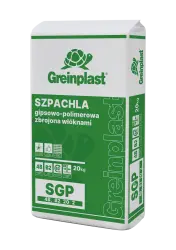

Used to lute and smoothen drywall boards, to level and fill in losses in mineral bases, inside buildings, in rooms not exposed to continuous moisture. The surfacer can also be used to join drywall boards with the use of reinforcing materials (mesh, paper, tape etc.). The product is classified as thin-layer gypsum plaster, B2/20/2 type. It also meets the requirements for 2B type surfacers. It can be applied on mineral bases, such as: cement, cement-lime and gypsum plasters, drywalls and âPro-Montaâ boards, concrete, cellular concrete etc.
Packaged in 20, and 5kg containers.
Preparation of mass: A correct amount of surfacer should be poured into clean water and stirred until a smooth mass without lumps is obtained. ca. 0,40 l of water should be added per 1 kg of dry mix. Put the mass aside for ca. 5 minutes, then stir again. Clean tools and containers must be used in surfacer preparation. Each time, only such amount of material should be prepared that will ensure its consumptionin 60 minutes. Remainders of set plaster considerably reduce the setting time. Unused, hardening material cannot be diluted in water again.
Luting: Distribute the mass evenly, pressing strongly against the base. The maximum layer thickness is 5 mm. The layer thickness has a significant influence on the surfacer drying time. After complete drying, the application of further layers is possible, until desired effects are achieved. When pointing drywall panels, use reinforcement tapes. To this end, put a surfacer layer into the joint, and then press the reinforcement tape inside. At the next stage, the joint should be luted again. Such surfaces can be finished with gypsum finishing coat, GREINPLAST GG, or with ready-to-use internal finishing coat, GREINPLAST SA.
The temperature of the base and its surroundings during the application and drying should not be lower than +5°C and higher than +30°C. The optimal application temperature is +20°C. Secure surfaces exposed to contamination; any stains should be removed before drying. The specified processing times may be subject to considerable variations under the influence of adverse thermal and moisture conditions. Any attempts to change the composition of the product are not allowed, as they may considerably reduce the quality of applied material.
Information contained in the manual help ensure the optimal use of the product, however, it does not create any legal liability of the Manufacturer, due to the fact that the conditions of use remain outside of its control. Surfacer consumption depends on the evenness degree at the base.